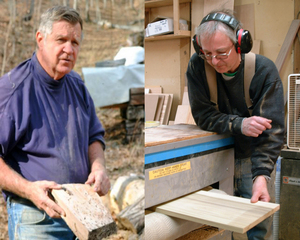

Tom Ilowiecki, left, uses wood salvaged from power line clearing, his fire woodpile, and from friends and neighbors. Joel Harte in his workshop, right. (Photos by Hank Daniel)
We asked these woodworkers: What is the distinction between craft and art - and the blurring of craft and art.
-- Ilowiecki says, "I don't look at myself as an artist. In my opinion, if I'm making a round bowl or spindles that requires nothing more than using lathe tools, I consider that craftsmanship. But when I'm creating a segmented bowl or piece of jewelry -- using different woods, colors and designs -- that's more artistic."
-- Tillson states, "As long as I've read and studied about wood turning, there has always been the debate about whether turning is craft or art. I'm convinced there will never be a clear-cut difference between the two and, as long as I love what I do, the distinction doesn't matter to me. If Picasso "turned' a little bowl to wash his paint brushes in, it would be sold for thousands of dollars, sit in a museum somewhere, and be called art. It's a skill like painting or sculpture, and the end result stands on its own to be judged by the ones around us. It's a matter of social and financial influences that wave and fluctuate like the wind. There is no clear distinction. On the other hand, if it sells for more than $600.00, it's art."
-- Harte muses, "Craft and art....Without the craft, the understanding of how to get from one point to another in your medium, and the ability to produce accurately what you are trying to attempt, art would just be an accidental, hit-or-miss affair. The art comes in when you put yourself into your work and are able to produce something that has a life of its own."
-- According to Sproll, "The craft belongs to the artisan who can take new visionary art and enhance a noteworthy artist's conception far beyond its original, regardless of whether it is music, the spoken word, sculptures, or paintings. An artist is someone who creates new frontiers and directions that are notably different from their predecessors. Both artists and artisans have inseparable gifts to offer. The artist's work could not flourish without the artisan's further enhancement throughout any period."
Sproll notes, "However, we should not forget the professional tradesman, who is neither of the above, but carries on the tradition and keeps it alive. The tradesman is invaluable in his expertise to take what the artist and artisan have created and make it both an ergonomically correct and cost-effective product. Carried out effectively, this is in itself no small challenge. As we all know only too well, not all artistic creations are at first practical."
He concludes, "The blurring of craft and art is in the very values of an individual or a group, similar to that of the tree trunk versus the branches. Where does one stop and the other start? All are indispensable and necessary to create the overall effect. Example: although I consider myself an artist for breaking ground in combining unusual design and exceptionally enhanced technological pieces, I am just a branch to such Bauhaus designers as Mies van der Rohe and Marcel Breuer. Therefore, I ask you, am I an artist or an artisan? It really makes no difference. I do it for the love of art."
BACK TO THE main story, "Once Upon A Tree: Turning Wood into Art."